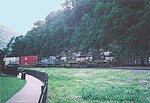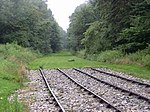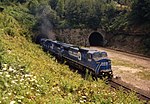Horseshoe Curve (Pennsylvania)

The Horseshoe Curve is a three-track railroad curve on Norfolk Southern Railway's Pittsburgh Line in Blair County, Pennsylvania. The curve is roughly 2,375 feet (700 m) long and 1,300 feet (400 m) in diameter. Completed in 1854 by the Pennsylvania Railroad as a way to reduce the westbound grade to the summit of the Allegheny Mountains, it replaced the time-consuming Allegheny Portage Railroad, which was the only other route across the mountains for large vehicles. The curve was later owned and used by three Pennsylvania Railroad successors: Penn Central, Conrail and Norfolk Southern. The Horseshoe Curve was added to the National Register of Historic Places and designated as a National Historic Landmark in 1966. It became a National Historic Civil Engineering Landmark in 2004. Horseshoe Curve has long been a tourist attraction. A trackside observation park was completed in 1879. The park was renovated and a visitor center built in the early 1990s. The Railroaders Memorial Museum in Altoona manages the center, which has exhibits pertaining to the curve.
Excerpt from the Wikipedia article Horseshoe Curve (Pennsylvania) (License: CC BY-SA 3.0, Authors, Images).Horseshoe Curve (Pennsylvania)
Veterans Memorial Highway, Logan Township
Geographical coordinates (GPS) Address Nearby Places Show on map
Geographical coordinates (GPS)
| Latitude | Longitude |
|---|---|
| N 40.497638888889 ° | E -78.484166666667 ° |
Address
Horseshoe Curve Visitors Center
Veterans Memorial Highway
16629 Logan Township
Pennsylvania, United States
Open on Google Maps




